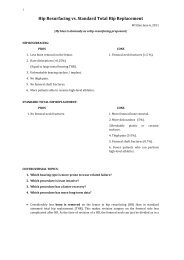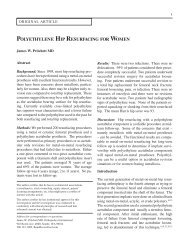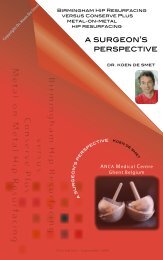Hip and Knee Arthroplasty - Surface Hippy Guide to Hip Resurfacing
Hip and Knee Arthroplasty - Surface Hippy Guide to Hip Resurfacing
Hip and Knee Arthroplasty - Surface Hippy Guide to Hip Resurfacing
You also want an ePaper? Increase the reach of your titles
YUMPU automatically turns print PDFs into web optimized ePapers that Google loves.
eplacement, however this combination has not<br />
been re-identified in this report.<br />
The largest group is the “Re-identified <strong>and</strong> no<br />
longer used” group which contains three<br />
prostheses combinations, three acetabular<br />
components <strong>and</strong> one femoral stem (Tables HT47-<br />
HT49). Although the Margron stem was used in<br />
2007 it was included in this group as the<br />
company notified the Registry early in 2008 that<br />
the prosthesis was no longer available.<br />
One prosthesis combination <strong>and</strong> three individual<br />
components (one stem <strong>and</strong> two acetabular<br />
components) have been re-identified by the<br />
Registry as having a higher than anticipated<br />
revision rate <strong>and</strong> are still being used. These are<br />
the F2L Multineck/Delta stem/acetabular<br />
combination, Profemur Z stem <strong>and</strong> the MBA <strong>and</strong><br />
SPH-Blind acetabular components (Tables HT47-<br />
HT49). Over recent years the use of each of<br />
these prostheses has decreased considerably.<br />
Graphs of the cumulative percent revision<br />
comparing these ‘re-identified <strong>and</strong> still used’<br />
prostheses <strong>to</strong> all other conventional <strong>to</strong>tal hip<br />
procedures are presented in Figures HT34-HT37.<br />
Prostheses <strong>and</strong> prostheses combinations that are<br />
being identified for the first time include the<br />
Corail/ASR femoral/acetabular combination,<br />
Adapter (cemented), Anca Fit, Hayes Consensus<br />
<strong>and</strong> Lyderic II (cemented) femoral stems <strong>and</strong> the<br />
Bionik acetabular component (Tables HT47-HT49<br />
<strong>and</strong> Figures HT38-43).<br />
The stems identified for the first time this year<br />
have exchangeable necks, as with the reidentified<br />
Margron, Profemur Z <strong>and</strong> the F2L<br />
Multineck stems. The Registry links a neck<br />
exchange <strong>to</strong> the stem even if the intraosseous<br />
component of the stem is not revised. The<br />
Registry is able <strong>to</strong> distinguish these two different<br />
types of stem revision.<br />
It could be argued that revisions involving neck<br />
exchange but not the intraosseous component of<br />
a stem may unfairly identify that particular stem<br />
as having a higher revision rate than a stem<br />
which does not have the capacity <strong>to</strong> exchange<br />
the neck. This is particularly so if neck exchange<br />
was undertaken simply <strong>to</strong> alter neck orientation,<br />
increase length or gain access <strong>to</strong> acetabular<br />
components. It remains Registry policy <strong>to</strong><br />
attribute revision <strong>to</strong> all components rather than a<br />
single component used in the primary procedure.<br />
For example, in the instance of an acetabular<br />
only revision, the revision is linked <strong>to</strong> both the<br />
original acetabular <strong>and</strong> femoral components. The<br />
reason for this is <strong>to</strong> take in<strong>to</strong> account the<br />
potential for adverse outcomes occurring from<br />
the interaction of the individual components.<br />
The Registry has <strong>and</strong> will continue <strong>to</strong> identify<br />
single components when the analysis clearly<br />
demonstrates the component has a higher than<br />
anticipated rate of revision no matter what other<br />
components it is combined with. This is true for<br />
each of the individual stems identified.<br />
The Registry has information on over 20 different<br />
femoral stems that have exchangeable necks.<br />
Many have been used in quite large numbers <strong>and</strong><br />
the majority of these prostheses have not been<br />
identified as having a higher than anticipated rate<br />
of revision. The identification of this number of<br />
stems with the capacity for neck exchange must<br />
raise the question as <strong>to</strong> whether this approach <strong>to</strong><br />
prosthesis design has the potential <strong>to</strong> increase<br />
the risk of revision.<br />
The Adapter femoral stem has a cemented <strong>and</strong> a<br />
cementless version. The Registry has identified<br />
the cemented Adapter stem as having a higher<br />
than anticipated rate of revision (Adj HR=3.60;<br />
95% CI (1.50, 8.66) p=0.0042). The two year<br />
cumulative percent revision is 7.1%. The period<br />
of follow up for this prosthesis is short with only<br />
100 procedures recorded using this stem <strong>and</strong><br />
most of these were in 2007.<br />
The Anca Fit stem has had limited use both in<br />
terms of number <strong>and</strong> location <strong>and</strong> most<br />
procedures using this prosthesis were undertaken<br />
in 2007. It has however been identified as<br />
having a higher than anticipated rate of revision<br />
(Adj HR=3.00; 95% CI (1.43, 6.30) p=0.0037).<br />
The Hayes Consensus femoral stem has 2.2<br />
revisions per 100 component years (Adj HR=2.3;<br />
95% CI (1.19, 4.38) p=0.0135). There have<br />
been 189 prostheses implanted with nine<br />
revisions, three for dislocation <strong>and</strong> four for<br />
loosening. The three year cumulative revision is<br />
4.6%.<br />
The Lyderic II femoral stem is an infrequently<br />
used prosthesis. It has a cemented (Lyderic II)<br />
<strong>and</strong> a cementless (Lyderic II HAP) version. The<br />
cemented version, Lyderic II, has been identified<br />
as having a higher than anticipated revision rate<br />
(Adj HR=2.99; 95% CI (1.23, 7.14) p=0.0151).<br />
Lyderic II has 2.54 revisions per 100 observed<br />
component years <strong>and</strong> a three year cumulative<br />
percent revision of 8.5%.<br />
The ASR cup is used for <strong>to</strong>tal resurfacing <strong>and</strong><br />
conventional primary <strong>to</strong>tal hip replacement. It<br />
has been re-identified in this report as having a<br />
higher than anticipated rate of revision when<br />
used in <strong>to</strong>tal resurfacing procedures. This year<br />
the Registry has also identified the ASR cup as<br />
having a higher than anticipated rate of revision<br />
in conventional <strong>to</strong>tal hip replacement when<br />
combined with the Corail stem. The Corail/ASR<br />
58






